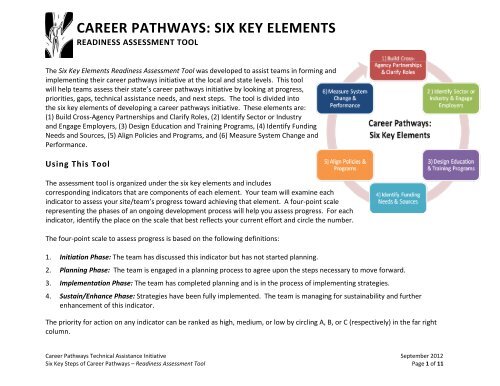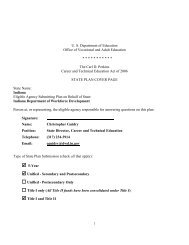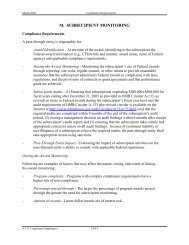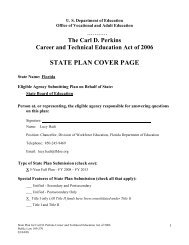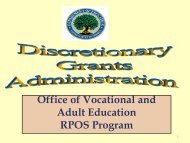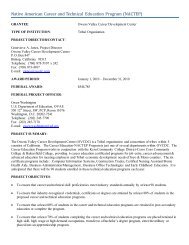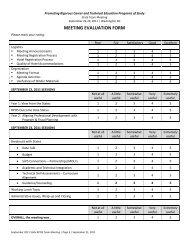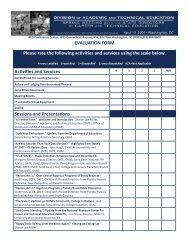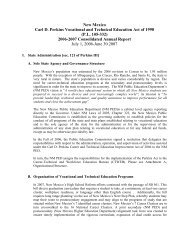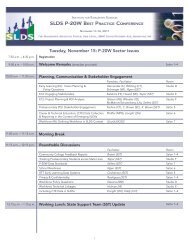Career Pathways: Six Key Elements â Readiness ... - Workforce 3 One
Career Pathways: Six Key Elements â Readiness ... - Workforce 3 One
Career Pathways: Six Key Elements â Readiness ... - Workforce 3 One
Create successful ePaper yourself
Turn your PDF publications into a flip-book with our unique Google optimized e-Paper software.
CAREER PATHWAYS: SIX KEY ELEMENTS<br />
READINESS ASSESSMENT TOOL<br />
The <strong>Six</strong> <strong>Key</strong> <strong>Elements</strong> <strong>Readiness</strong> Assessment Tool was developed to assist teams in forming and<br />
implementing their career pathways initiative at the local and state levels. This tool<br />
will help teams assess their state’s career pathways initiative by looking at progress,<br />
priorities, gaps, technical assistance needs, and next steps. The tool is divided into<br />
the six key elements of developing a career pathways initiative. These elements are:<br />
(1) Build Cross‐Agency Partnerships and Clarify Roles, (2) Identify Sector or Industry<br />
and Engage Employers, (3) Design Education and Training Programs, (4) Identify Funding<br />
Needs and Sources, (5) Align Policies and Programs, and (6) Measure System Change and<br />
Performance.<br />
Using This Tool<br />
The assessment tool is organized under the six key elements and includes<br />
corresponding indicators that are components of each element. Your team will examine each<br />
indicator to assess your site/team’s progress toward achieving that element. A four‐point scale<br />
representing the phases of an ongoing development process will help you assess progress. For each<br />
indicator, identify the place on the scale that best reflects your current effort and circle the number.<br />
The four‐point scale to assess progress is based on the following definitions:<br />
1. Initiation Phase: The team has discussed this indicator but has not started planning.<br />
2. Planning Phase: The team is engaged in a planning process to agree upon the steps necessary to move forward.<br />
3. Implementation Phase: The team has completed planning and is in the process of implementing strategies.<br />
4. Sustain/Enhance Phase: Strategies have been fully implemented. The team is managing for sustainability and further<br />
enhancement of this indicator.<br />
The priority for action on any indicator can be ranked as high, medium, or low by circling A, B, or C (respectively) in the far right<br />
column.<br />
<strong>Career</strong> <strong>Pathways</strong> Technical Assistance Initiative September 2012<br />
<strong>Six</strong> <strong>Key</strong> Steps of <strong>Career</strong> <strong>Pathways</strong> – <strong>Readiness</strong> Assessment Tool Page 1 of 11
<strong>Career</strong> <strong>Pathways</strong>: <strong>Six</strong> <strong>Key</strong> <strong>Elements</strong> – <strong>Readiness</strong> Assessment Tool<br />
1. Build Cross‐Agency Partnerships & Clarify Roles<br />
Please indicate the phase of implementation of your state for each of the key components listed.<br />
Also, indicate the level of priority for each action.<br />
1. <strong>Key</strong> agency partners at the local level, are engaged, including:<br />
<br />
<br />
<br />
<br />
<br />
<br />
<br />
<strong>Workforce</strong> Investment Board(s) and local workforce development agencies<br />
Community College(s) and Postsecondary Education Providers<br />
Adult Basic Education providers<br />
TANF providers and Human service agencies<br />
Economic Development agencies<br />
Community‐based organizations<br />
Business representative(s)<br />
2. <strong>Key</strong> agency partners at the state level are engaged, including:<br />
<br />
<br />
<br />
<br />
State <strong>Workforce</strong> Agency<br />
Adult Basic and Postsecondary Education<br />
Economic Development<br />
Human Services<br />
Initiation Phase<br />
Planning Phase<br />
Implementation<br />
Phase<br />
Sustain/<br />
Enhance Phase<br />
Priority<br />
for Action<br />
1 2 3 4 A B C<br />
1 2 3 4 A B C<br />
3. Written memoranda of understanding clearly define the agreed upon roles and<br />
responsibilities of partnership members. 1 2 3 4 A B C<br />
4. A leadership or steering committee has been established to guide the process of developing a<br />
career pathways system. 1 2 3 4 A B C<br />
5. A labor market analysis and environmental scan of education and training providers has been<br />
completed. 1 2 3 4 A B C<br />
<strong>Career</strong> <strong>Pathways</strong> Technical Assistance Initiative September 2012<br />
<strong>Six</strong> <strong>Key</strong> <strong>Elements</strong> of <strong>Career</strong> <strong>Pathways</strong> – <strong>Readiness</strong> Assessment Tool Page 2 of 11
<strong>Career</strong> <strong>Pathways</strong>: <strong>Six</strong> <strong>Key</strong> <strong>Elements</strong> – <strong>Readiness</strong> Assessment Tool<br />
1. Build Cross‐Agency Partnerships & Clarify Roles<br />
Please indicate the phase of implementation of your state for each of the key components listed.<br />
Also, indicate the level of priority for each action.<br />
Initiation Phase<br />
Planning Phase<br />
Implementation<br />
Phase<br />
Sustain/<br />
Enhance Phase<br />
Priority<br />
for Action<br />
6. Partners agree on a definition of a career pathways framework. 1 2 3 4 A B C<br />
7. A set of common goals and shared vision for establishing a career pathways framework has<br />
been developed.<br />
8. Senior or political leaders in the state/region are aware of and have pledged support for the<br />
initiative.<br />
1 2 3 4 A B C<br />
1 2 3 4 A B C<br />
<strong>Career</strong> <strong>Pathways</strong> Technical Assistance Initiative September 2012<br />
<strong>Six</strong> <strong>Key</strong> <strong>Elements</strong> of <strong>Career</strong> <strong>Pathways</strong> – <strong>Readiness</strong> Assessment Tool Page 3 of 11
<strong>Career</strong> <strong>Pathways</strong>: <strong>Six</strong> <strong>Key</strong> <strong>Elements</strong> – <strong>Readiness</strong> Assessment Tool<br />
2. Identify Sector or Industry and Engage Employers<br />
Please indicate the phase of implementation of your state for each of the key components listed.<br />
Also, indicate the level of priority for each action.<br />
Initiation Phase<br />
Planning Phase<br />
Implementation<br />
Phase<br />
Sustain/<br />
Enhance Phase<br />
Priority<br />
for Action<br />
1. Current and projected labor demand and supply have been assessed. 1 2 3 4 A B C<br />
2. Sector(s) including high demand and growth industries are identified and selected.<br />
List sector(s):<br />
3. The education and skill needs of employers in the state/region have been analyzed and gaps<br />
identified.<br />
4. The strengths, weaknesses, challenges, and gaps within the state and region’s education and<br />
training programs have been assessed against meeting sector and industry training needs.<br />
5. The partners have developed an outreach strategy to determine which employers to target and<br />
how to engage them.<br />
1 2 3 4 A B C<br />
1 2 3 4 A B C<br />
1 2 3 4 A B C<br />
1 2 3 4 A B C<br />
6. Employers representing targeted industries have been engaged. 1 2 3 4 A B C<br />
7. A plan is in place to support working with employers during various phases of the project (design,<br />
launch, operation, and evaluation).<br />
1 2 3 4 A B C<br />
<strong>Career</strong> <strong>Pathways</strong> Technical Assistance Initiative September 2012<br />
<strong>Six</strong> <strong>Key</strong> <strong>Elements</strong> of <strong>Career</strong> <strong>Pathways</strong> – <strong>Readiness</strong> Assessment Tool Page 4 of 11
<strong>Career</strong> <strong>Pathways</strong>: <strong>Six</strong> <strong>Key</strong> <strong>Elements</strong> – <strong>Readiness</strong> Assessment Tool<br />
3. Design Education and Training Programs<br />
Please indicate the phase of implementation of your state for each of the key components listed.<br />
Also, indicate the level of priority for each action.<br />
1. Occupations and pathways are employer‐vetted and informed, and meet the skill needs of<br />
targeted high‐growth sectors.<br />
2. Education and training is non‐duplicative and progressive, clearly articulating one level of<br />
instruction to the next and enabling students to move easily between academic and career<br />
technical programs, and to and from work.<br />
Initiation Phase<br />
Planning Phase<br />
Implementation<br />
Phase<br />
Sustain/<br />
Enhance Phase<br />
Priority<br />
for Action<br />
1 2 3 4 A B C<br />
1 2 3 4 A B C<br />
3. Programs are designed with multiple entry points and exit points (on‐ramps and off‐ramps). 1 2 3 4 A B C<br />
4. Curricula is “chunked” or organized in progressive modules, with each level clearly articulated<br />
to the next.<br />
5. Training helps workers enter or advance within a specific sector or occupational field,<br />
regardless of their skills at the point of entry.<br />
6. Curricula and instructional strategies are contextual and competency‐based; they make work<br />
a central context for learning and help students attain work readiness skills.<br />
7. Adult basic education programs are clearly articulated with postsecondary academic and<br />
career‐technical programs.<br />
8. Programs are designed to accelerate advancement into either postsecondary education or<br />
employment, shortening the duration of training or education.<br />
9. Appropriate assessment tools determine placement and advancement, including credit for<br />
prior learning.<br />
10. Programs lead to industry‐recognized and/or postsecondary credentials that are stackable<br />
and articulate to progressively higher‐level credentials or degrees.<br />
1 2 3 4 A B C<br />
1 2 3 4 A B C<br />
1 2 3 4 A B C<br />
1 2 3 4 A B C<br />
1 2 3 4 A B C<br />
1 2 3 4 A B C<br />
1 2 3 4 A B C<br />
<strong>Career</strong> <strong>Pathways</strong> Technical Assistance Initiative September 2012<br />
<strong>Six</strong> <strong>Key</strong> <strong>Elements</strong> of <strong>Career</strong> <strong>Pathways</strong> – <strong>Readiness</strong> Assessment Tool Page 5 of 11
<strong>Career</strong> <strong>Pathways</strong>: <strong>Six</strong> <strong>Key</strong> <strong>Elements</strong> – <strong>Readiness</strong> Assessment Tool<br />
3. Design Education and Training Programs<br />
Please indicate the phase of implementation of your state for each of the key components listed.<br />
Also, indicate the level of priority for each action.<br />
11. Individualized career plans support an individual’s journey through the pathway and provide<br />
“roadmaps” for participants to attain the education, training and credentials they need to<br />
reach their goal.<br />
12. Wrap‐around support services are available, including job placement services, career and<br />
financial aid counseling, especially during points of transition.<br />
13. Training is accessible and flexible by site and schedule, reduces or accommodates language<br />
and learning barriers, and develops drop‐out prevention services or policies.<br />
14. Programs are organized to meet the unique needs of adult learners (including childcare,<br />
accommodating work schedules with flexible and non‐semester‐based scheduling, alternative<br />
class times and locations, easy entry and exit points, learning cohorts, and the innovative use<br />
of technology).<br />
Initiation Phase<br />
Planning Phase<br />
Implementation<br />
Phase<br />
Sustain/<br />
Enhance Phase<br />
Priority<br />
for Action<br />
1 2 3 4 A B C<br />
1 2 3 4 A B C<br />
1 2 3 4 A B C<br />
1 2 3 4 A B C<br />
<strong>Career</strong> <strong>Pathways</strong> Technical Assistance Initiative September 2012<br />
<strong>Six</strong> <strong>Key</strong> <strong>Elements</strong> of <strong>Career</strong> <strong>Pathways</strong> – <strong>Readiness</strong> Assessment Tool Page 6 of 11
<strong>Career</strong> <strong>Pathways</strong>: <strong>Six</strong> <strong>Key</strong> <strong>Elements</strong> – <strong>Readiness</strong> Assessment Tool<br />
4. Identify Funding Needs and Sources<br />
Please indicate the phase of implementation of your state for each of the key components listed.<br />
Also, indicate the level of priority for each action.<br />
1. Partners identified funding needs for developing core components of the career pathway<br />
system including:<br />
<br />
<br />
<br />
<br />
<br />
Program development<br />
Professional development<br />
Operating costs<br />
Supportive services<br />
Other<br />
Initiation Phase<br />
Planning Phase<br />
Implementation<br />
Phase<br />
Sustain/<br />
Enhance Phase<br />
Priority<br />
for Action<br />
1 2 3 4 A B C<br />
2. Partners explored funding resources that could support the career pathway system,<br />
including:<br />
WIA Titles I, II, and IV<br />
Wagner‐Peyser Act funds<br />
Carl Perkins Act funds<br />
TANF funds<br />
State funding<br />
Private foundations<br />
Employers<br />
Other<br />
1 2 3 4 A B C<br />
<strong>Career</strong> <strong>Pathways</strong> Technical Assistance Initiative September 2012<br />
<strong>Six</strong> <strong>Key</strong> <strong>Elements</strong> of <strong>Career</strong> <strong>Pathways</strong> – <strong>Readiness</strong> Assessment Tool Page 7 of 11
<strong>Career</strong> <strong>Pathways</strong>: <strong>Six</strong> <strong>Key</strong> <strong>Elements</strong> – <strong>Readiness</strong> Assessment Tool<br />
4. Identify Funding Needs and Sources<br />
Please indicate the phase of implementation of your state for each of the key components listed.<br />
Also, indicate the level of priority for each action.<br />
3. Partners assessed the financial resources necessary for covering the training costs of<br />
individual participants, including:<br />
<br />
<br />
<br />
<br />
<br />
Improving counseling and assistance to students in accessing student aid (Title IV HEA)<br />
Paying tuition and related costs with student aid programs (e.g. Pell grants, state grant<br />
programs)<br />
Paying tuition and related costs with WIA funding (including continued training after<br />
initial employment placements toward higher level credentials)<br />
Attracting and expanding employer‐provided training, utilization of tax credits, etc.<br />
Covering indirect costs of attendance.<br />
Initiation Phase<br />
Planning Phase<br />
Implementation<br />
Phase<br />
Sustain/<br />
Enhance Phase<br />
Priority<br />
for Action<br />
1 2 3 4 A B C<br />
<strong>Career</strong> <strong>Pathways</strong> Technical Assistance Initiative September 2012<br />
<strong>Six</strong> <strong>Key</strong> <strong>Elements</strong> of <strong>Career</strong> <strong>Pathways</strong> – <strong>Readiness</strong> Assessment Tool Page 8 of 11
<strong>Career</strong> <strong>Pathways</strong>: <strong>Six</strong> <strong>Key</strong> <strong>Elements</strong> – <strong>Readiness</strong> Assessment Tool<br />
5. Align Policies and Programs<br />
Please indicate the phase of implementation of your state for each of the key components listed.<br />
Also, indicate the level of priority for each action.<br />
1. Local and state partners identified key policy and program changes and action steps<br />
necessary to implement the goals and vision for the career pathways initiative, including<br />
coordinating efforts across the state and/or region.<br />
Initiation Phase<br />
Planning Phase<br />
Implementation<br />
Phase<br />
Sustain/<br />
Enhance Phase<br />
Priority<br />
for<br />
Action<br />
1 2 3 4 A B C<br />
2. Local and state policymakers support a coordinated, systems approach to adult<br />
education and training. 1 2 3 4 A B C<br />
3. Administrative policies have been assessed for each of the partner agencies (workforce,<br />
education, human services, economic development) and opportunities/barriers to<br />
alignment have been identified around the following topics:<br />
Allowable uses of funds, including cost‐sharing agreements<br />
Program Eligibility<br />
Performance reporting requirements<br />
Financial reporting requirements<br />
Other<br />
1 2 3 4 A B C<br />
4. Legislative policy reforms to support a career pathways system have been identified and<br />
communicated to relevant authorities and policymakers. 1 2 3 4 A B C<br />
5. A cross‐program, and cross‐agency professional development strategy is in place.<br />
1 2 3 4 A B C<br />
<strong>Career</strong> <strong>Pathways</strong> Technical Assistance Initiative September 2012<br />
<strong>Six</strong> <strong>Key</strong> <strong>Elements</strong> of <strong>Career</strong> <strong>Pathways</strong> – <strong>Readiness</strong> Assessment Tool Page 9 of 11
<strong>Career</strong> <strong>Pathways</strong>: <strong>Six</strong> <strong>Key</strong> <strong>Elements</strong> – <strong>Readiness</strong> Assessment Tool<br />
6. Measure System Change and Performance<br />
Please indicate the phase of implementation of your state for each of the key components listed.<br />
Also, indicate the level of priority for each action.<br />
Initiation Phase<br />
Planning Phase<br />
Implementation<br />
Phase<br />
Sustain/<br />
Enhance Phase<br />
Priority<br />
for<br />
Action<br />
1. A scan of all of the performance measures that are connected to your career<br />
pathways programs<br />
2. Common measures have been identified and are used to evaluate participant outcomes,<br />
including:<br />
<br />
<br />
Measures that encourage long‐term strategies for meeting the needs of low‐skilled<br />
participants<br />
Interim measures.<br />
1 2 3 4 A B C<br />
3. Longitudinal data collection and analysis measures student learning gains, progress along<br />
educational pathways, credential attainment, and employment outcomes.<br />
1 2 3 4 A B C<br />
4. Data is used to make program improvements.<br />
5. Regular assessments are used to support continuous improvement, including:<br />
Conducting regular in‐process reviews<br />
Reviewing overall performance<br />
Evaluating the performance of partners<br />
Optimizing scale based on needs for services<br />
Reevaluating the mission, vision, and goals<br />
1 2 3 4 A B C<br />
1 2 3 4 A B C<br />
<strong>Career</strong> <strong>Pathways</strong> Technical Assistance Initiative September 2012<br />
<strong>Six</strong> <strong>Key</strong> <strong>Elements</strong> of <strong>Career</strong> <strong>Pathways</strong> – <strong>Readiness</strong> Assessment Tool Page 10 of 11
<strong>Career</strong> <strong>Pathways</strong>: <strong>Six</strong> <strong>Key</strong> <strong>Elements</strong> – <strong>Readiness</strong> Assessment Tool<br />
6. Measure System Change and Performance<br />
Please indicate the phase of implementation of your state for each of the key components listed.<br />
Also, indicate the level of priority for each action.<br />
6. Evaluations are used to improve career pathways and to maintain (or attract) partnerships.<br />
7. Funding is reserved or secured for external or intensive program evaluations.<br />
8. Data is used to identify labor market changes and to make system changes on a real‐time<br />
basis.<br />
9. Measures are used to assess and determine system change and performance (including<br />
policy changes for system‐wide change).<br />
10. A cross‐program, and cross‐agency professional development strategy is in place.<br />
11. The Eligible Training Provider List (ETPL) promote the development of career pathways.<br />
Initiation Phase<br />
Planning Phase<br />
Implementation<br />
Phase<br />
Sustain/<br />
Enhance Phase<br />
Priority<br />
for<br />
Action<br />
1 2 3 4 A B C<br />
1 2 3 4 A B C<br />
1 2 3 4 A B C<br />
1 2 3 4 A B C<br />
1 2 3 4 A B C<br />
1 2 3 4 A B C<br />
<strong>Career</strong> <strong>Pathways</strong> Technical Assistance Initiative September 2012<br />
<strong>Six</strong> <strong>Key</strong> <strong>Elements</strong> of <strong>Career</strong> <strong>Pathways</strong> – <strong>Readiness</strong> Assessment Tool Page 11 of 11


